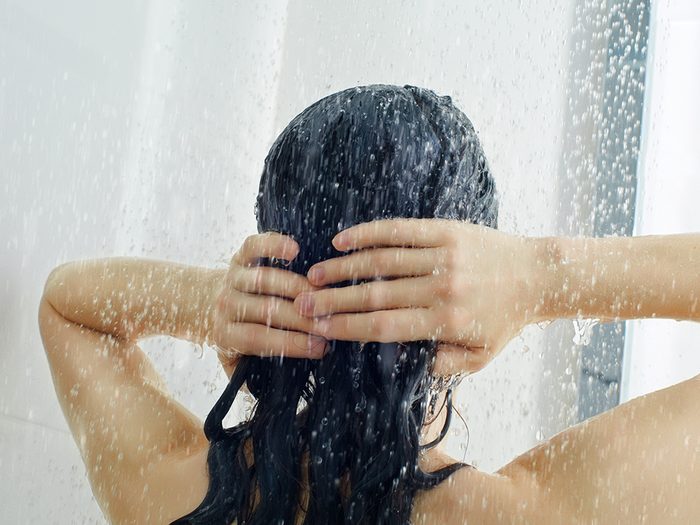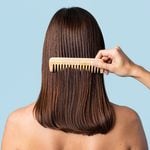Are You Washing Your Hair Properly?

Hair washing might not be as easy as lather, rinse, and repeat. Here's how to properly wash your hair with the right technique and products.
Shampooing and conditioning your hair seems like a simple concept. You lather, rinse, and repeat. But if you don’t pay close attention to your hair type, you may end up making common healthy hair mistakes that can cause damage.
The products and technique you should use depend on your hair type and how often it gets dirty. Here, a hairstyle and a dermatologist offer their tips to get healthy, beautiful hair.
(Related: Everything You Need to Know About Scalp Care, the Latest Trend in Skin Care)
How often should you wash your hair?
Before knowing how to wash you hair properly, you need to know how often you should wash it. The answer: It depends on your hair type and texture, says hairstylist Catalina Drouillard, owner of Three Sixteen Hair Haven in Kihei, Hawaii.
“An oily scalp and fine hair may require daily shampooing, while coarse, dry hair could only require shampooing once a week,” she explains. “Generally, though, every other day or every third day is often enough for most types of hair.”
On the opposite end of the spectrum, you may think you’re doing your locks a favor by washing as often as possible and getting them extras-clean. But it’s possible to wash your hair too often. Washing your hair every day is too much for most people, Drouillard says.
“If your hair feels dry and brittle you could be shampooing too often with the wrong type of shampoo for your hair,” she says.
(Related: 5 Reasons to Stop Washing Your Hair)
How to properly wash your hair
Before you get started, brushing out all tangles will help keep it from getting matted when you’re shampooing in the shower, Drouillard says. Apply shampoo, then massage your hair down to your scalp with your fingertips. Allow the shampoo to rinse down the hair shaft as opposed to piling hair on top of your head while rubbing in the shampoo. This will stop it from tangling.
Make sure the water isn’t too hot, as hot water can dry the hair and the scalp, causing brittle hair and/or dandruff, Drouillard says.
“It’s also important to be gentle with the scalp,” adds Rajani Katta, MD, a board-certified dermatologist in Houston and author of Glow: The Dermatologist’s Guide to a Whole Foods Younger Skin Diet. “You don’t want to scratch at your scalp, so it’s important to use your fingertips and not your fingernails.”
How much shampoo to use
There is some truth to the saying, “lather, rinse, repeat.” According to Drouillard, if you’re not shampooing every day or if you’re shampooing your hair because you exercised and your hair got sweaty, you should lather up and rinse out your shampoo twice.
How much conditioner to use
After lathering and rinsing out your shampoo, you should massage in some conditioner, Drouillard says. If you don’t have oily hair, you can opt to use only conditioners on days you don’t wash your hair. That will give you a boost of added moisture.
“Anyone with any length of hair needs a conditioner, every time they shampoo,” she says. “If the risk of limp hair makes you want to skip conditioner, be sure to use a conditioner that isn’t too heavy for your texture and never put conditioner on the scalp.”
Make sure to rinse out every bit of conditioner to prevent it from weighing down your hair or creating buildup on the scalp, Drouillard says.
“A final rinse in cold water really does make a difference, as it will close the cuticle resulting in smoother, shinier hair.”
(Related: It’s Time to Try the “No ‘Poo” Method of Hair Care)
How to choose shampoos and conditioners
From salon shelves to drugstore aisles, there’s a wide range selection when it comes to shampoos and conditioners. You generally get what you pay for with hair care, so it can be worth it to invest a few extra dollars on your products, Drouillard says.
“Pricier products usually means higher quality ingredients,” she says. “But if your hair is healthy, I wouldn’t argue that your products aren’t good; your hair will speak to that.”
Much like how often you should wash your hair, what type of shampoo and conditioner you should look for depends on your hair type and texture, Drouillard says. You’ll also want to avoid products containing parabens and sulfates, which can be damaging and drying. She is a fan of the Paul Mitchell Clean Beauty line, which is made of natural, vegan ingredients, and has options for dry, damaged, frizzy, and normal hair.
“Most brands will have separate lines to address different needs,” she says. “If you have color-treated, dry, damaged, or thin hair, you should find a shampoo and conditioner for that type of hair.”
If your hair is very dry, Drouillard advises avoiding using anything claiming to be clarifying more than once a week. She typically doesn’t recommend two-in-one shampoo and conditioner products, particularly if you have an oily scalp, as a conditioning shampoo will just put more moisture on top of your oil instead of cleansing.
(Related: Do Shampoo Bars Work?)
How should you dry your hair?
Whether you’re going to blow dry or air dry your hair, you will likely want to pat it dry of excess water with a towel first. If you do this, be gentle because your hair can be damaged when it’s wet: Rubbing it vigorously can cause breakage and rough up the cuticle, creating frizz, Drouillard says.
“Since your hair is weakest when wet, it also isn’t the best idea to tie it up tightly right after a shower, as that can cause breakage from the hair elastic/ponytail holder,” she says. “A turban towel is my favourite thing, as it helps soak up moisture and stays on my head while I get dressed and do my makeup.”
When it comes to blow-drying, Drouillard recommends using heat as infrequently as possible. But, if you must, allow your hair to air dry as long as possible. Follow this by using a heat protectant styling product to prevent damage.
(Related: This Is How Bad It Is to Sleep with Wet Hair)
What to do if you have dandruff
If you’re experiencing dandruff, it can be bothersome for various reasons, from scalp irritation to unsightly flakes. Dandruff can often be remedied with inexpensive drugstore shampoos, but for extreme irritation, your best bet is to visit a dermatologist, Dr. Katta says.
“For most people who notice excessive flaking of their scalp, it’s usually due to a condition called seborrheic dermatitis, which is inflammation of the scalp,” she says.
She adds: “Although this condition might look as though the scalp is dry, it’s actually inflamed. For this condition, washing more frequently to remove the oil from the scalp is actually helpful.”
Dr. Katta advises gently rubbing in medicated shampoo (again, with your fingertips and not your nails) to the scalp as a treatment for dandruff, and leaving it there for 10 to 15 minutes before washing out.
(Related: 5 Sneaky Reasons You Suddenly Have Dandruff)
When to see a dermatologist
If using over-the-counter dandruff shampoos isn’t helping your dandruff, Dr. Katta recommends seeing a dermatologist to receive an accurate diagnosis. Even if it is just dandruff, your doctor may be able to prescribe a medicated shampoo that can be more effective than what you’ve tried already. It’s also important to see your dermatologist if you are experiencing hair loss since dandruff is not usually a cause of hair loss, she adds.
Next: The Trendy Hair Product Ingredient That Fixes All Your Hair Woes




